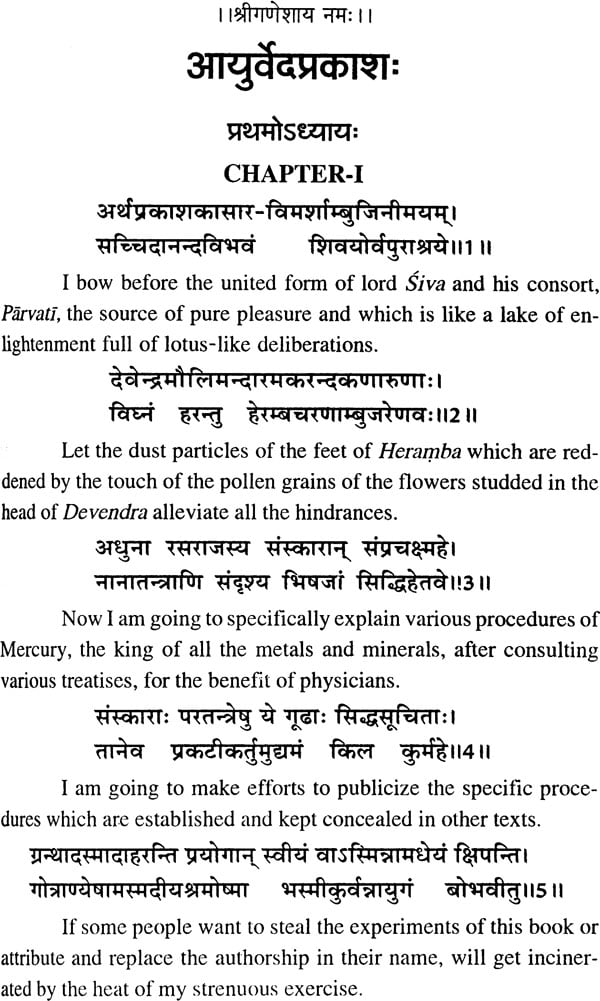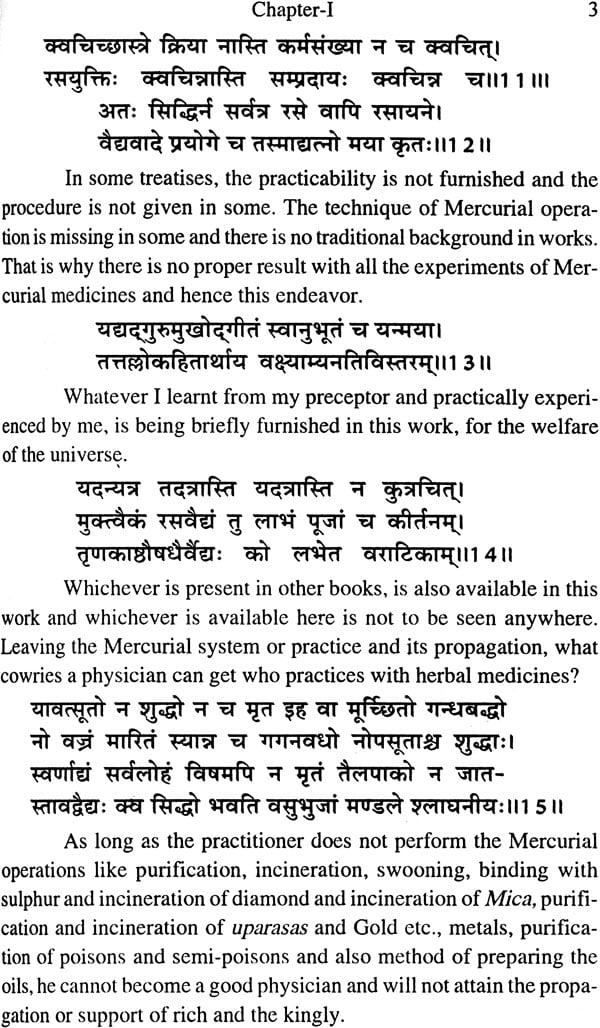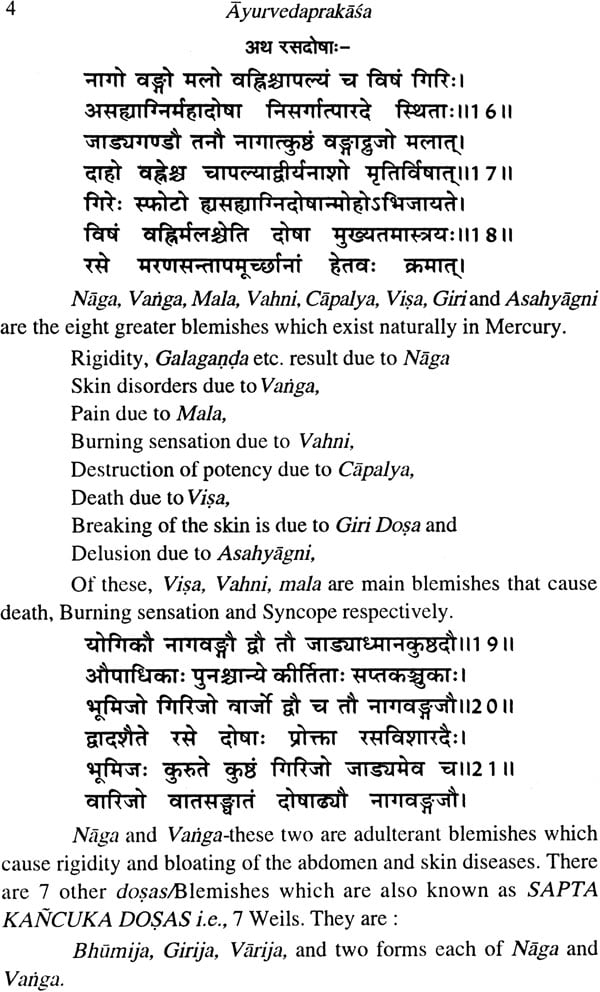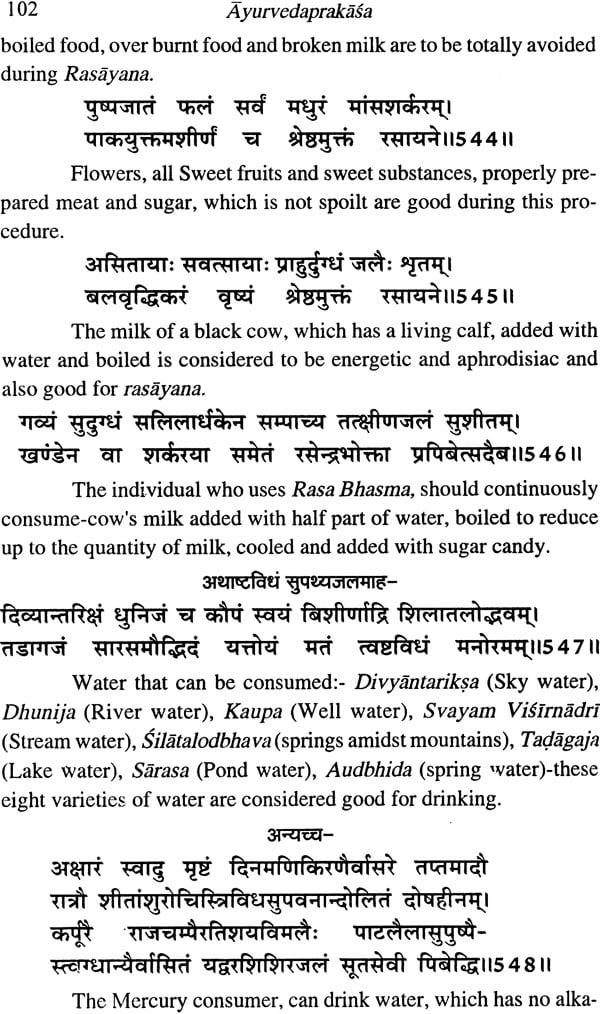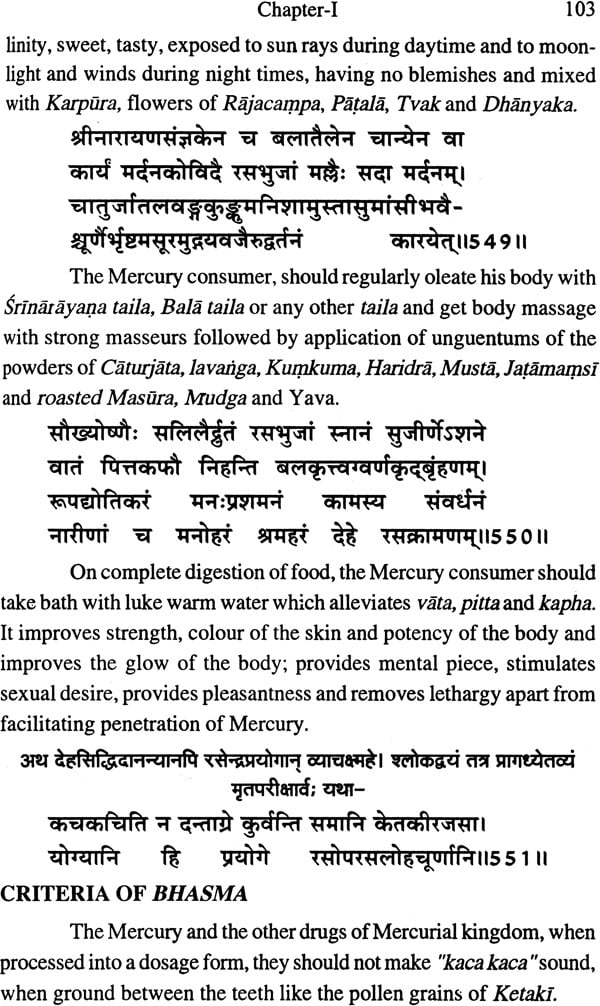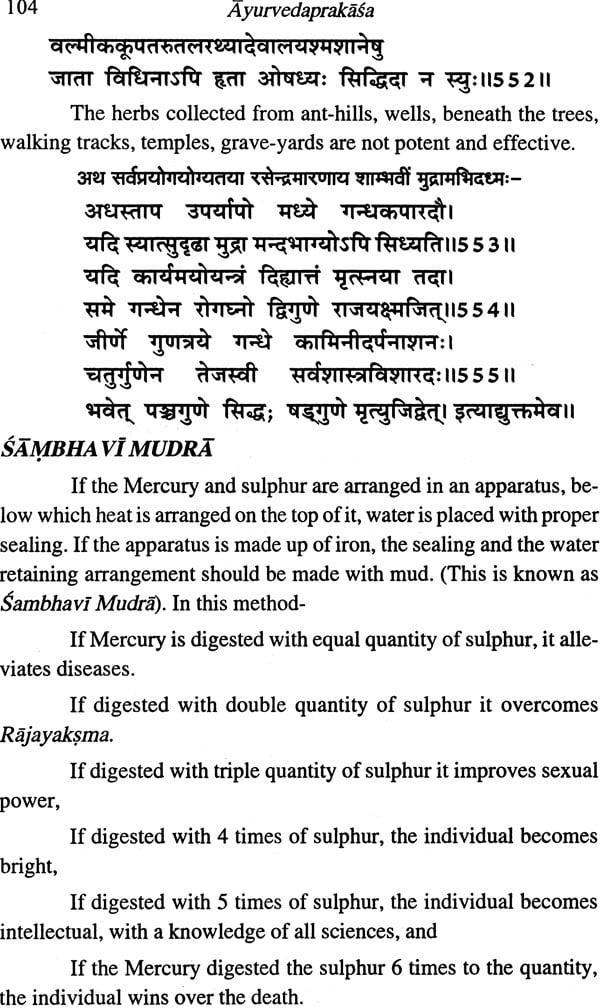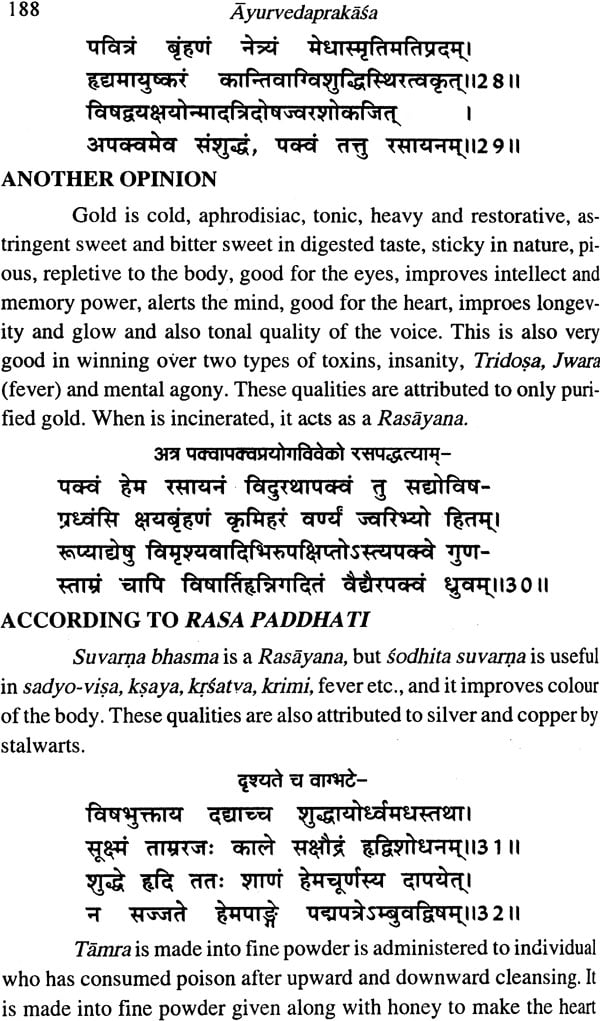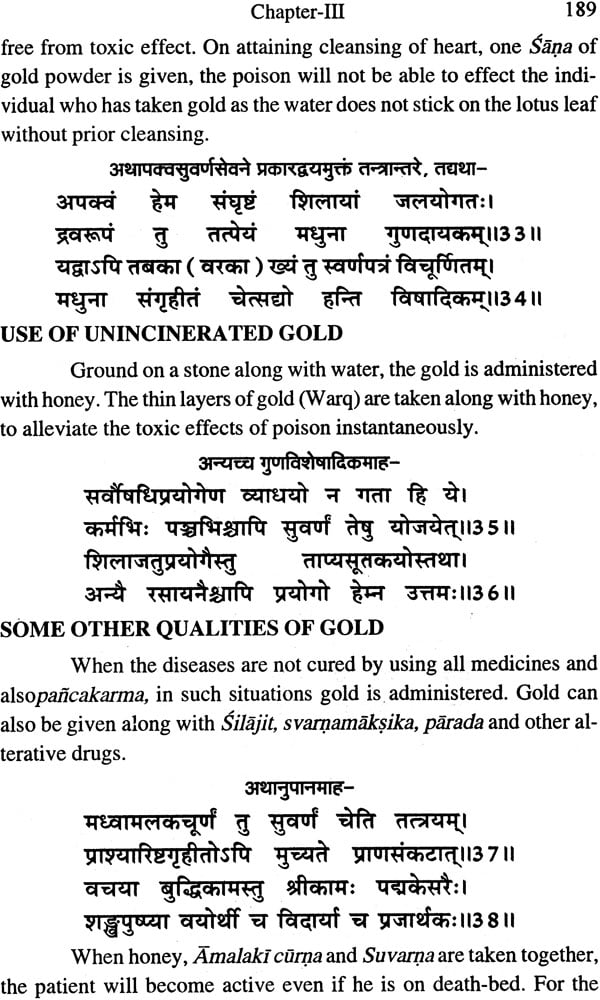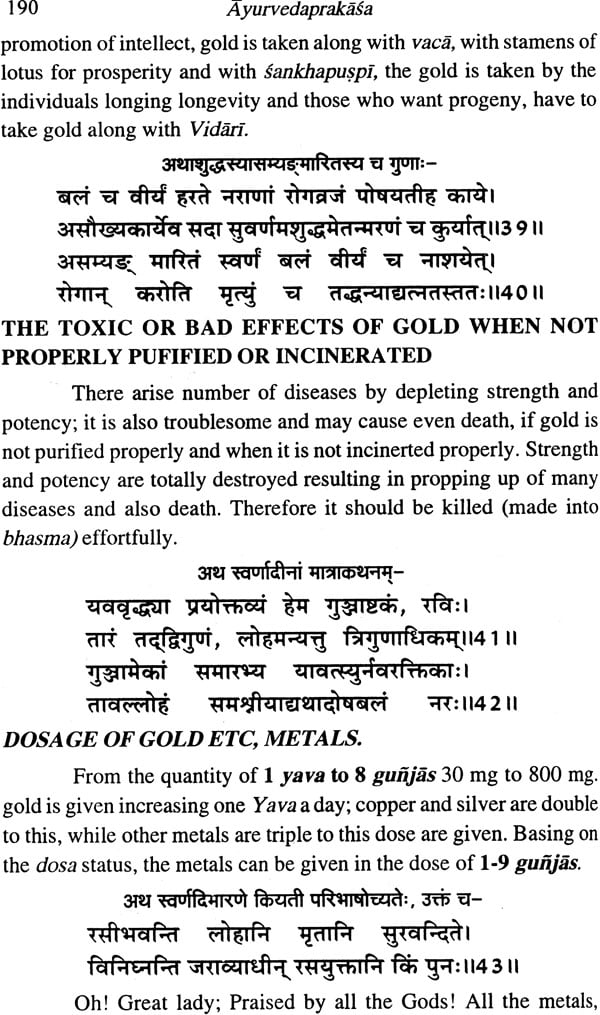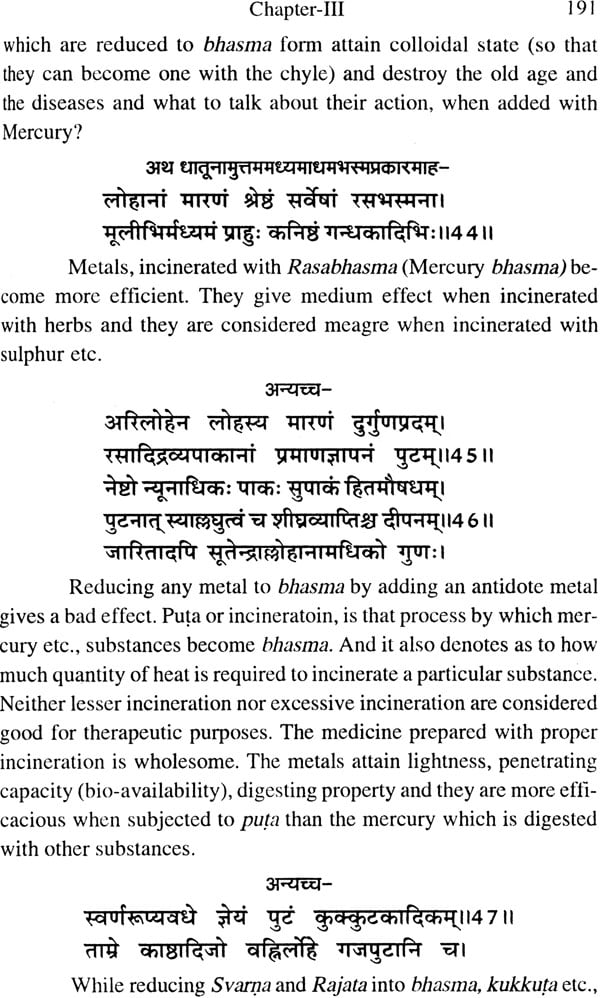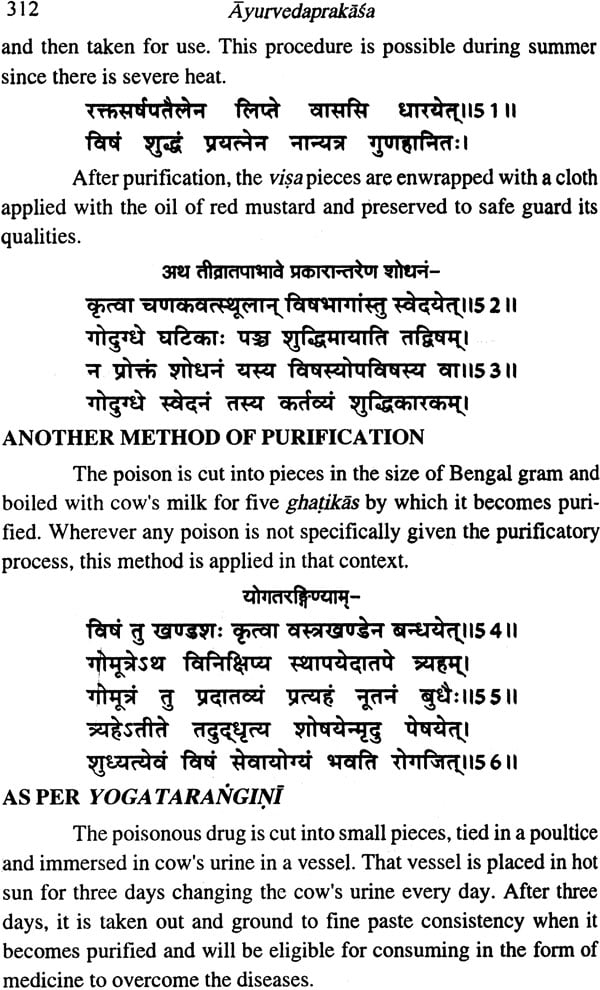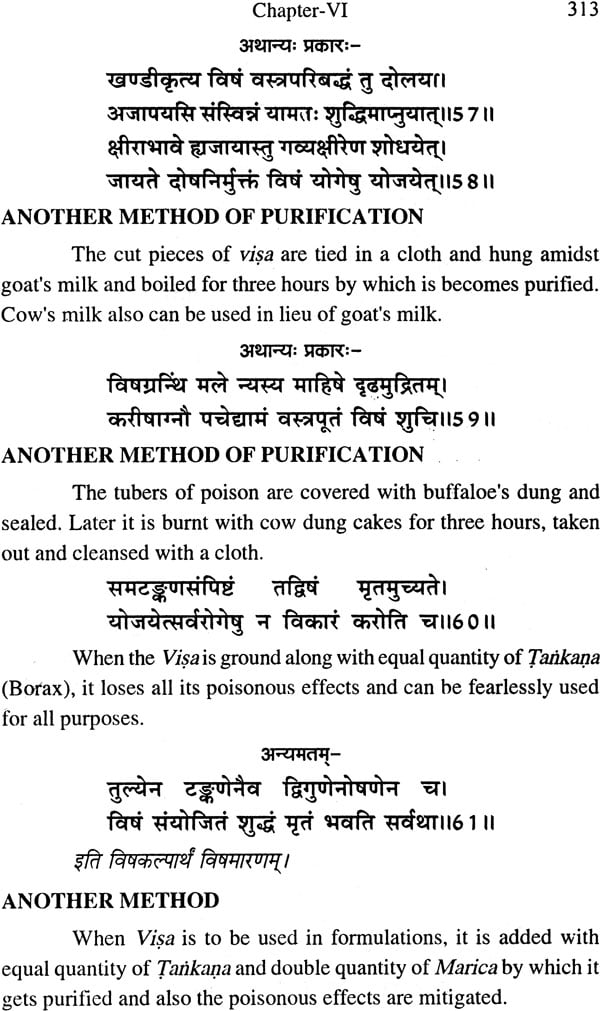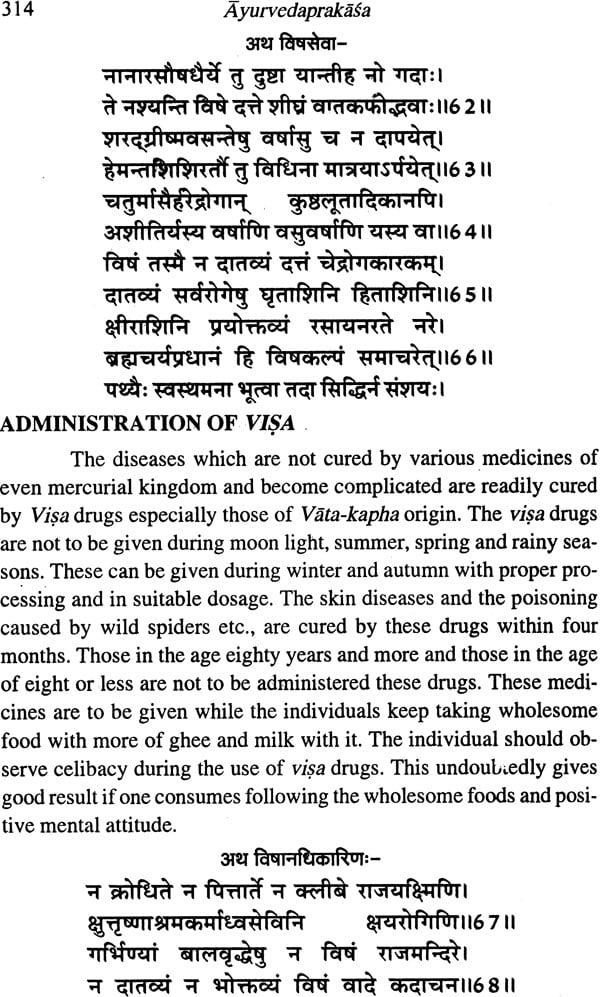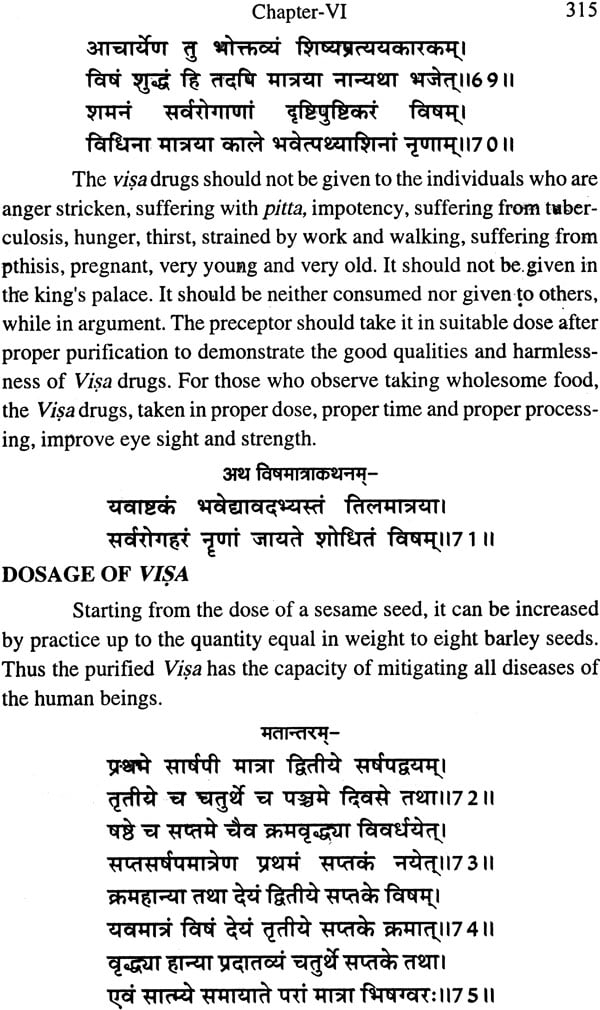
Ayurveda Prakasa of Sri Madhava Upadhyaya
Book Specification
| Item Code: | NAN340 |
| Author: | Prof. P. H. C. Murthy |
| Publisher: | Chowkhamba Sanskrit Series Office |
| Language: | Sanskrit Text With English Translation |
| Edition: | 2017 |
| ISBN: | 9788170804833 |
| Pages: | 326 |
| Cover: | Hardcover |
| Other Details | 9.0 inch X 5.5 inch |
| Weight | 420 gm |
Book Description
"Those physicians who expect result from mercury without feeding it black mica, gold and sulphur and those farmers who expect yield from the field without sowing seed are fools" This statement clears all doubts and fears about the practice of Mercurial system. Those who come across the statements about the magical results of mercurial compounds should view them in this perspective. Rasasastra the mercurial system is the first science that has warned about the toxicity of using raw and unprocessed Mercury. It has cautioned to the extent that unpurified Mercury could cause even death. Therefore the iatro-chemistry of Rasasatra should be understood safe and effective since the raw materials undergo diligent processing before making them into a dosage form.
Ayurvedaprakasa gives practical details of making mercurial medicines. The author Madhava Upadhyaya mentions at the outset that he would furnish only practicable technicalities in this book and would not give the details which he has not experienced. He emphasizes the significance of both theory and practice equally in learning Rasasastra. The author laments over the quackery in Rasasastra practice and emphasizes the importance of following the mercurial procedures diligently. This is evident by going through this precise compendium of Rasasastra, the Mercurial system. Apart from his personal experiences he has also quoted the practical oriented procedures from other text books -Rasarajaiaksmi, Rasapaddhati, Rasaratnasamuccaya, Resecintamani, Yogsteretigini etc., famous books. Ayurvedaprakasa seems to be the essence of the material available until time of Miidhava Upadhyaya.
The subject matter has been presented in six chapters in this book.
The first chapter deals with the significance of Mercurial system and the importance of learning this science under direct supervision of an able and benevolent guru. The properties, blemishes, purificatory measures along with semskara, bandha etc., of mercury that transform the status of this substance from a poison to a cectar, The methods of preparing Rasa bhasma and Ressussdhis and administering them on the body are given. Though it looks like a magic, certain transmutational techniques and an animated pill are also described in this chapter.
Second chapter provides the details of uparasas, the mercurial associate drugs i.e., sulphur, cinnabar, mica, orpiment, realgar, stibnite, lapis lazuli, chalk, ochere, green vitreol are described by their features, purification etc., methods along with usage.
The metals are described in detailed manner in the third chapter. The purification and incineration methods of metals are given with dosage and usage. These derivations alleviate all the fears about the metallic preparations for therapeutic use. The details of adverse drug reactions that occur when these metals are improperly used and also the management furnished in this context give encouragement for successful practice of Mercurial medicine.
The minerals like cha1copyrites, ironpyrites, bornite, plum- bum oxide and the alloys like bronze, brass and five-metal alloy are described in the fourth chapter. The same chapter contains the details on collection, purification, and processing of Silajatu into a dosage form.
The fifth chapter deals with gemology. The mercurial system and its relation with precious and semiprecious stones along with their therapeutic usage apart from the astrological connections with planets are given in detail. The valuation system of gems is given in a such a methodical manner that it can be adopted even today with slight modifications as per the present measurement system.
The toxicology is detailed in the sixth chapter. The poisons or the toxic substances of static and mobile nature are described with toxicological effects and managements apart from their individual therapeutic usage. Certain sacred chanting (mantras) are also given to overcome instantaneously the poisonous effect caused by toxic substances (vise) and also snake bite and the scorpion sting. Certain anti-poisonous medicines are also given. And finally a precise description of preparing alkaline substances is provided to wind up the text.
Msdhava upadhyaya, the author of this treatise belongs to Sarawata Brahmana dyanasly of Saurastra. Referred to as Rasamadhava by the followers of mercurial medicine, he lived in Varanasi when he composed this text Ayurveda prakasa. There are many Mtidheves who have written books on various desciplines of Indian Philosophical thought system apart from Madhavakara the author of Madhavanidana. Though there is no hint about the time of Madhava upadhyaya, the author of Ayurveda prakasa, it can be understood by the referances of phiranga, Rasakarpura etc., that this author may be placed in the mid seventeenth century, A. D.
As said earlier this book is a ready reckoner for scholars, practitioners, and researchers of Rasasatra. In view of the increasing demand for translation of such important work it has been ventured by me. The experience of writing a text book in Rasasastra and teaching the subject for the last 38 years with the blessings of my father, late Sesagiri Sarma, his guru Hakim Hussain Zulkhemain and my gurus prof. Hari Shankar sarma ji and late. M. U. Bahadur ji has helped to a great extent. Dr. Bhuvana, Dr. Bhagya, Dr. Shiva, Dr. Sai, Dr. Vijaya and others have helped in preparing the script. Pavan kumar Sharma, my disciple in sitar has assisted in preparing the index and introduction. I wish them all a very bright and prosperous career. My wife Smt. Padmaja, my daughter Dr. Sivapriya, my son-in-law Dr. Jayakrishna Kulamarva, my son Chayanath and my daughter-in-law Anuradha have encouraged me throughout this project as always. I wish them all a very bright future. Sri Brijmohan Das Gupta of Chowkhamba Sanskrit series office, Varanasi has readily accepted for taking up this project for which I am very much grateful to him.
Contents
| Chapter-1 | 1-113 | |
| Mangalacarana | 1 | |
| Rasa dosas | 4 | |
| Ksncuka dosa | 4 | |
| Rasa samskara | 6 | |
| Svedana | 8 | |
| Mardana | 10 | |
| Murcchana | 11 | |
| Utthapana | 12 | |
| Patana | 13 | |
| Adhah patana | 14 | |
| Tiryak patana | 15 | |
| Bodhana | 16 | |
| Niyamanam | 18 | |
| Sandipana | 19 | |
| Anuvasana | 19 | |
| Jarana | 20 | |
| The result of gandhaka jarana | 22 | |
| Gandhaka jarana | 23 | |
| Purificaton of mercury according to rasa ratnakara | 30 | |
| Taptakhalva | 31 | |
| Appetizing the purified mercury | 33 | |
| According to sarngadhara | 34 | |
| According to sivagama | 35 | |
| Valuka yantra | 35 | |
| Kacchapa yantra | 39 | |
| Svarna jarana | 42 | |
| The material that helps mercury to digest metals | 42 | |
| Other vida yogas | 43 | |
| Vida according to siddha laksmisvara tantra | 44 | |
| Taptakhalva | 45 | |
| Hemajarana through dolayantra | 46 | |
| Hemagrasa in kacchapa yantra | 46 | |
| Jarana in dolayantra | 49 | |
| Ranjanam | 51 | |
| Tarabija | 51 | |
| Pratibija | 52 | |
| Hemabija | 52 | |
| Nagabija | 52 | |
| Sarana taila | 53 | |
| Loha bheki tara bheki | 57 | |
| Khota | 57 | |
| Bahyadruti | 59 | |
| Sarana taila | 59 | |
| Kramanam | 60 | |
| Jarana, vedhana and ranjana through khota process | 61 | |
| Hemakrsti | 62 | |
| Satamsa vedha | 62 | |
| Rajavati vidya | 64 | |
| Hemavati vidya | 65 | |
| Another hemavati technique | 65 | |
| The technique of rasabandhana | 67 | |
| Another method of binding mercury | 67 | |
| Jalauka bandha | 68 | |
| Hatha bandha | 69 | |
| Arota bandha | 69 | |
| Abhasa bandha | 69 | |
| Kriyahina bandha | 70 | |
| Pistika bandha | 70 | |
| Ksara bandha | 70 | |
| Khota bandha | 70 | |
| Pota bandha | 71 | |
| Kalka bandha | 71 | |
| Kajjali bandha | 71 | |
| Sajiva bandha | 71 | |
| Nirjiva bandha | 71 | |
| Sabija bandha | 72 | |
| Srnkhala bandha | 72 | |
| Druti bandha | 72 | |
| Bala bandha | 73 | |
| Kumara bandha | 73 | |
| Taruna bandha | 73 | |
| Vrddha bandha | 73 | |
| Murti bandha | 74 | |
| Jala bandha | 74 | |
| Agni bandha | 74 | |
| Maha bandha | 74 | |
| Rasamurcchana according to Nithyanatha | 75 | |
| Features of murcchita parada | 75 | |
| Result of murcchana | 75 | |
| Rasa bhasma | 76 | |
| Rasa sindura as per Rasa rajalaksmi | 76 | |
| Another method of rasasindura | 77 | |
| Unwholesome food duirng in take of mercurial compounds | 78 | |
| Rasakarpura | 79 | |
| Another method of rasakarpura | 81 | |
| Sindurarasa | 81 | |
| Method of rasabhasma | 83 | |
| Method of rasabhasma | 84 | |
| Method of rasabhasma | 84 | |
| Features of rasabhasma | 86 | |
| Qualities of rasabhasama | 87 | |
| Jalauka bandha | 89 | |
| Method of preparing jalauka | 89 | |
| Khechari gutika | 90 | |
| Method of administration of mercury | 91 | |
| According to nityanatha | 92 | |
| Administration of rasa | 93 | |
| Method of administration of mercury | 94 | |
| Dosage of mercury | 94 | |
| The result of taking hemajirna parada bhsma | 95 | |
| Anupana | 95 | |
| The dietetic and behaveoural regulations to follow while consuming mercury | 97 | |
| According to rasa vagbhata | 98 | |
| Apathya during rasasevana | 99 | |
| Management of rasajirna | 100 | |
| Criteria of bhasma | 103 | |
| Sambhavi mudra | 104 | |
| Gandhamrta rasa | 105 | |
| Hemasundara rasa | 105 | |
| Mrtyunjaya rasa | 106 | |
| Anandasuta rasa | 107 | |
| Pranikalpadrumagola rasa | 108 | |
| Sardula rasa | 109 | |
| Trinetra rasa | 109 | |
| Amrtarnava rasa | 110 | |
| Curna ratna | 110 | |
| Jayavati | 111 | |
| Gandhaloham | 111 | |
| Siddhalaksmisvara rasa | 112 | |
| Caturmukha rasa | 113 | |
| Chapter-2 | 114-182 | |
| Uparasah | 114 | |
| Gandhaka | 116 | |
| Properties of Gandhaka | 116 | |
| Bad effects of impure sulphur | 117 | |
| Purification of sulphur | 117 | |
| Features of Gandhaka to be taken for sodhana Procedure | 118 | |
| The significance of purification procedure | 119 | |
| Clarification about kurmaputa | 119 | |
| Method of removing the odour from sulphur | 120 | |
| Another method of usage of gandhaka | 120 | |
| Gandhaka taila | 120 | |
| Third gandhaka kalpa | 121 | |
| Fourth gandhaka kalpa | 121 | |
| Fifth gandhaka kalpa | 121 | |
| Sixth gandhaka kalpa | 122 | |
| The Seventh and best kalpa | 123 | |
| Eight gandhaka kalpa | 123 | |
| Ninth gandhaka kalpa | 124 | |
| Tenth gandhaka kalpa | 125 | |
| Eleventh gandhaka kalpa | 125 | |
| Gandhaka tailam | 125 | |
| Twelfth gandhaka kalpa | 125 | |
| Thirteenth kalpa in pruritus and other skin disorders | 126 | |
| Fourteenth gandhaka kalpa | 126 | |
| Names, features, qualities, origin and purification of Hingula (cinnabar) | 127 | |
| Qualities of Hingula | 127 | |
| The toxic effects of consuming impure Hinhula | 127 | |
| Purification of Hingula | 127 | |
| Incineration of Hingula | 128 | |
| Properties of artificial Hingula | 128 | |
| Preparation of artificial Hingula | 129 | |
| Extraction of mercury from Hingula | 130 | |
| Abhraka | 130 | |
| Varieties of abhraka | 131 | |
| Qualities of vajrabhraka | 132 | |
| Number of Putas to abhraka for various purpose | 134 | |
| Dosage and usage of abhraka bhasma | 134 | |
| Abhraka sodhana | 134 | |
| Dhanyabhraka | 135 | |
| Marana of abhraka | 136 | |
| Sataputa abharaka bhasma | 138 | |
| Sahasraputa abharaka bhasma | 138 | |
| Method of Making red coloured Abhraka bhasma | 141 | |
| Method of amrtikarana | 141 | |
| Unwholesome foods to be avoided during intake of Abharaka Bhasma | 142 | |
| Abhraka sattva | 142 | |
| Purification and incineration of abhraka sattva | 143 | |
| Properties of abhraka sattva | 144 | |
| General method of sattvaniskasana | 144 | |
| Druti | 145 | |
| Abhraka druti | 145 | |
| Druti melanam | 146 | |
| Ratna druti | 146 | |
| Abhraka Prayoga | 147 | |
| Haritala | 148 | |
| Properties | 148 | |
| Toxic effects caused by unpurified haritala bhasma | 149 | |
| Mrtalaksanam | 149 | |
| Incineration of talaka | 150 | |
| The usage of talaka as per laghuyogatarangini | 152 | |
| As per siddamata | 154 | |
| Sattvapatana of harita | 156 | |
| According to rasapaddhati | 156 | |
| Names, features, qualities, origin and purification of manassila | 157 | |
| Bad effects of impure manassila | 158 | |
| Purification | 158 | |
| Sattvapatana | 159 | |
| Srotoanjanam-names, varaities, properties and purification of anjana | 159 | |
| Features of anjana | 160 | |
| Quantities of both of these anjanas | 160 | |
| Purification of anjana | 161 | |
| Sattvapatana | 161 | |
| Rasanjana | 161 | |
| Qualities | 161 | |
| Nilanjana and puspanjana | 162 | |
| Purification of nilanjana | 162 | |
| Properties of kulittha | 163 | |
| Tankanaksara names, features qualities and pufification | 163 | |
| Rajavarta | 164 | |
| Sodhana and marana of rajavarta | 164 | |
| Sattvapatana of rajavarta | 165 | |
| Cumbaka | 165 | |
| Sphatika | 166 | |
| Qualities of sphatika | 166 | |
| Sankha | 167 | |
| Khatika | 167 | |
| Gairikam | 168 | |
| Qualities of gairika | 168 | |
| Kasisa | 169 | |
| Rasaka | 169 | |
| Purification | 170 | |
| Rasaka bhasma | 171 | |
| Rasaka sattva | 172 | |
| Kapardika | 172 | |
| Varata bhasma | 173 | |
| Sikata | 174 | |
| Bola | 174 | |
| Manusa bola | 175 | |
| Kankustha | 175 | |
| Saurastri | 176 | |
| Samudraphena | 177 | |
| Ksudra sankha | 177 | |
| Sukti | 178 | |
| Jala sukti | 178 | |
| Mukta sukti | 178 | |
| Krsna mrttika | 179 | |
| Panka | 179 | |
| Kampillaka | 179 | |
| Gauripasana | 180 | |
| Navasara | 180 | |
| Agnijara | 181 | |
| Girisinduram (montroydite) | 181 | |
| Vodarasrngam | 181 | |
| Chapter-3 | 183-237 | |
| Dhatavah (the metals) | 183 | |
| Definition of the word dhatu | 183 | |
| Sub metals | 184 | |
| Suvarna | 184 | |
| Synonyms of Gold in sanskrit | 186 | |
| Qualities of best svarana | 187 | |
| Properties of svarna | 187 | |
| Use of unincinerated gold | 189 | |
| Some other qualities of gold | 189 | |
| The toxic or bad effecs of gold when not properly purified or incinerated | 190 | |
| Dosage of gold etc. | 190 | |
| Purification of metals | 192 | |
| Purification of naga and vanga | 193 | |
| Bhasma of svarna etc., metals | 193 | |
| Incineration of all metals | 193 | |
| Svarna bhasma | 194 | |
| Making gold bhasma without mercury | 196 | |
| Suvarna bhasma Pariksa | 196 | |
| Suvarna druti | 197 | |
| Origination, names, features, qualities, Purification and incineration methods of raupya (Silver) | 197 | |
| Purification and incineration of rajata | 200 | |
| Druti (liquefaction) of silver and gold | 202 | |
| Tamra | 202 | |
| Toxicity of tamra | 203 | |
| Method of tamra sodhana | 203 | |
| Tamramarana | 204 | |
| Paradamarita tamra as per rasa paddhati | 206 | |
| Preparing tamra bhasma without mercury | 207 | |
| Somanathiya tamra bhasma | 207 | |
| Feathurs of tamra bhasma | 208 | |
| Properties of tamra | 208 | |
| Toxic effects of tamra | 209 | |
| The names, features, properties, sodhana and marana of vanga | 209 | |
| Properties of vanga | 209 | |
| Blemishes of impure and improperly incinerated vanga | 210 | |
| Method of peparing vanga bhasma | 211 | |
| Implications | 211 | |
| The method of preparing niruttha bhasma of vanga | 212 | |
| Yasada (zinc) | 215 | |
| Naga | 215 | |
| Marana of naga | 217 | |
| According to rasapaddhati | 218 | |
| Specific opinion of the author of rasa paddhati about naga bhasma | 219 | |
| Nagesvara | 220 | |
| Loha | 221 | |
| Identifying tiksna loha | 223 | |
| Features of kanta | 223 | |
| Blemishes of loha | 224 | |
| Blemishes caused by consuming unpurified loha | 225 | |
| Blemishes caused by improperly incinerated loha | 225 | |
| Anupana | 225 | |
| Incineration of loha | 226 | |
| Spedific purification of loha | 228 | |
| Spedific purification of kanta loha | 228 | |
| Suryatapi loha bhasma | 230 | |
| Mrtaloha | 234 | |
| Amrtikarana | 235 | |
| Mandura | 235 | |
| Chapter-4 | 238-263 | |
| Svarnamaksika (copper pyrites) | 238 | |
| The features of svarnamaksika | 239 | |
| Maksika sodhana | 240 | |
| Sattva niskasana (extration) | 240 | |
| Taramaksika | 241 | |
| Tuttha | 244 | |
| Marana of tuttha | 246 | |
| Sattva extraction from tuttha | 246 | |
| Bhunaga (earthworm) and its extract for ring | 246 | |
| Tuttha mudrika | 248 | |
| Kamsya (bronze) and pittala (brass) | 250 | |
| Pittala | 251 | |
| Sodhana and marana of bronze and brass | 253 | |
| Pancaloha | 254 | |
| Sinduram | 255 | |
| Silajatu | 256 | |
| Purification according to agnivesa | 259 | |
| Synonyms of silajatu | 260 | |
| Capala | 262 | |
| Chapter-5 | 264-303 | |
| Ratna (precious stones) | 264 | |
| Uparatna (semi-precious stones) | 265 | |
| Diamond | 267 | |
| Dosas (blemishes) | 271 | |
| The method of testing gems | 275 | |
| Mukta (pearl) | 276 | |
| Properties of diamond | 282 | |
| Incineration of diamond | 284 | |
| Vidruma (coral) | 286 | |
| Mukta (pearl) | 286 | |
| Manikya (ruby) | 288 | |
| Garutmatam (emerald) | 288 | |
| Vaiduryam (cat's eye) | 289 | |
| Gomedam (hessonite) | 290 | |
| Indranila (sapphire) | 291 | |
| Pusparaga (topaz) | 292 | |
| The five gems | 294 | |
| Sphatika (rock crystal) | 294 | |
| Sunstone (Suryakanta) | 295 | |
| Moonstone (candrkanta) | 296 | |
| Perojaka (turquoise matri) | 297 | |
| Making bhasma of gems | 297 | |
| Substitution for gem stones | 298 | |
| Vaikranta | 299 | |
| The location of nine gems in a ring | 302 | |
| Druti of gems | 302 | |
| Chapter-6 | 304-326 | |
| Origination of visa | 304 | |
| Purification of visa | 311 | |
| Dosage of visa | 315 | |
| The wholesome food during the intake of visa | 316 | |
| Upavisa | 322 | |
| Purification of upavisa | 323 | |
| Visa tailam | 324 | |
| Visa vajrapata rasa | 324 | |
| Lavanabhedi sudhanindhi rasa | 325 | |
| Ksara kalpana | 326 |
